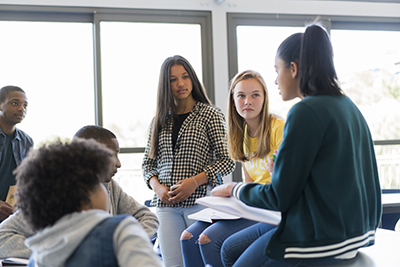Instruction in Spanish: Las prácticas de la disciplina del Marco ALE

The WIDA Español team has developed the Marco de referencia de las artes del lenguaje del español de WIDA (Marco ALE), a Spanish language arts framework. The publication will be released this fall via two documents: Aplicación para la actualización y desarrollo de estándares and Aplicación para la enseñanza. The first document serves as a guide for professionals charged with creating Spanish language arts norms or standards at the school, district or even the state level. The second document serves as a resource for teachers interested in exploring the elements of the framework to enrich their teaching. Both documents are anchored on the same Marco ALE.
As part of the development of the Marco ALE, the WIDA Español team conducted an analysis of Spanish language arts literature, a review of standards and related documents in the field from Latin American countries and the United States and conversations with leading scholars, administrators and classroom experts on Spanish language arts. As a result, the Marco ALE is made up of three ideologías orientadoras, seven prácticas de la disciplina and four conceptos básicos that serve as the basis for Spanish language arts. In this web article, we present two of the prácticas: los recursos del lenguaje and la crítica del razonamiento.
One of the practices of the Marco ALE is on the use of los recursos del lenguaje, the use of language resources, including multimodal and translinguistic representations, to communicate messages specific to the sociocultural context. During the analysis of Spanish language arts standards, it became evident that several Latin American countries support the use of languages other than Spanish in the teaching of Spanish language arts. For example, in the case of students living in linguistically diverse spaces, including places where indigenous dialects or languages are maintained and Spanish is taught as an additional language, it is important that students have opportunities to use all of their linguistic assets while learning Spanish. This practice opens the door to opportunities such as the use of translanguaging in the Spanish language arts classroom.
Educators can leverage characteristics of translanguaging as a way to teach Spanish language arts. For example, teachers and students can identify forms of communication that may break the grammatical norms of Spanish. The use of Anglicisms in Spanish, such as blue jean and bluyín or hippie and jipi, can be explored in order to identify in which contexts the use of Anglicisms is acceptable or not, and why. Likewise, concepts in Spanish that have no English translation, including estrenar, tocayo or madrugar, can be explored in the language arts classroom. This type of exploration across and in-between languages encourages the strategic and authentic use of language — particularly for bi/multilingual learners residing in linguistically diverse communities.
Another one of the practices of the Marco ALE talks about the construction of arguments and críticas del razonamiento, critiques of other’s rationale by using multimodal, bi/multilingual and multicultural sources. Teachers who work in the field of Spanish language arts will notice that this practice is key to the development of every student. However, this practice turns intention into action by expecting students to develop critical reasoning using evidence that represents a variety of modalities (e.g., books, videos and audios), languages and cultures. For students who live across cultures, such as students in transnational regions or students who regularly engage with multiple languages, it is important to emphasize the importance of using all of their skills and valuing evidence in multiple languages when formulating an analysis and/or a critique.
The construction of arguments is nothing new. However, this practice elevates the need for developing arguments using evidence from multimodal, bi/multilingual and multicultural sources. In the classroom, teachers can apply this críticas del razonamiento practice using a variety of modalities. Teachers can start with a written critique made up of textual evidence and ask students to identify videos, podcasts, street art, poems, and other items that support the argument. Students can also draw on the knowledge and experiences of their family or their community, adding bi/multilingual and multicultural elements to the conversation. The purpose of this example is not to eliminate the use of written texts but rather to create opportunities where the focus is the integration of multimodal tools when composing a critique.
The Marco ALE includes five additional prácticas de la disciplina: collaborative learning, text creation, text analysis, metacognition and metalinguistic awareness and information synthesis. In the Aplicación para la eseñanza document of Marco ALE, teachers and administrators of Spanish language arts programs will find support for each of the seven practices. The document includes sample academic standards, sample lessons and mini-instruments or tools that teachers can use to adopt each practice. After the publication of this document in the fall of 2021, WIDA Español will also be preparing professional learning workshops for teachers of Spanish language arts. To stay informed about the publication of the Marco ALE documents and other WIDA Español resources, be sure to use the news signup form and manage your email preferences by selecting WIDA Español as an area of interest.
About the series: Instruction in Spanish
This article is part of a series published by WIDA Español titled “Instruction in Spanish/Instrucción en español.” Each of the articles in this series will focus on instructional practices for Spanish language arts and/or Spanish language development. The series presents ideas, practices and tools for educators of bi/multilingual students delivering Spanish instruction.
About the authors
Analleli Muñoz is an assistant director of professional learning at WIDA focused on strengthening the development and delivery of WIDA Español professional learning offerings and resources to support educators serving emergent bilinguals.
Samuel Aguirre is the director of WIDA Español and assistant director of consortium relations. As director of WIDA Español, Sam manages the research, development and delivery of WIDA resources focused on Spanish language instruction in the United States and abroad. His work oversees major areas, including those of frameworks for Spanish language development and Spanish language arts, professional learning opportunities for educators working with Spanish and Spanish-English bilingual education programs and Spanish language assessment.
To stay informed about WIDA Español resources, tools and services use the news signup form to manage email preferences and select WIDA Español as an interest area.





